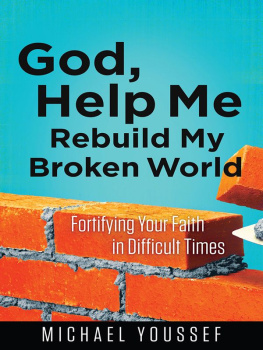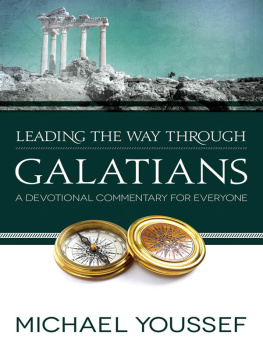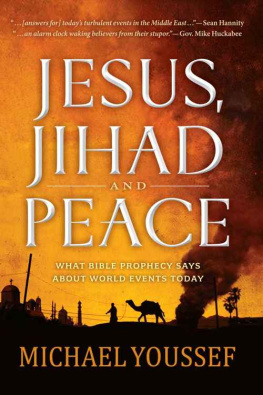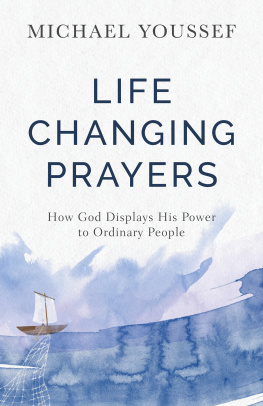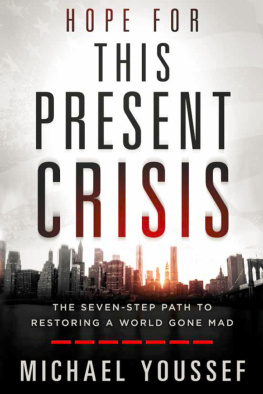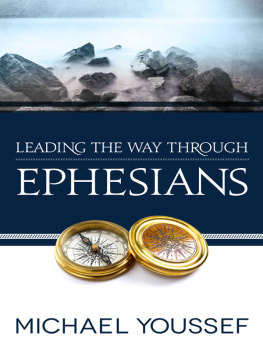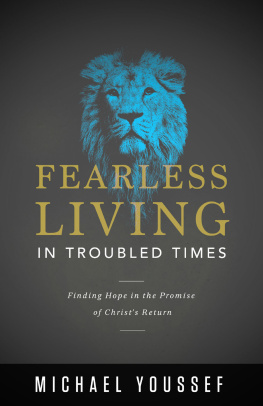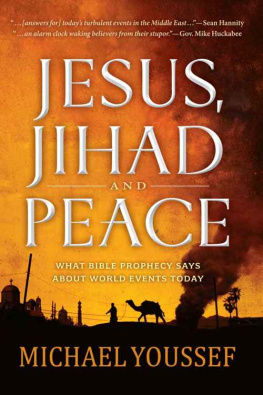I offer all my thanksgiving to the Father in heaven whose Holy Spirit has laid on my heart the writing of this book for the glory of Jesus. I am also immensely grateful to the Lord for sending me an able and gifted editor and compiler of my material in Jim Denney.
Special thanks to the entire team at Harvest House Publishersand especially to Bob Hawkins Jr. and LaRae Weikert, who shared my vision and made this dream a reality.
My expression of thanks would not be complete without mentioning the patience and perseverance of Don Gatess literary agency for managing the many details of such an undertaking.
My earnest prayer is that, as I leave this legacy to the next generation, God would raise up great men and women to faithfully serve their generation by accurately interpreting the Word of God.
M ichael Youssef, PhD, is the founder and president of Leading The Way, a worldwide ministry that leads the way for people living in spiritual darkness to discover the light of Christ through the creative use of media and on-the-ground ministry teams. His weekly television programs and daily radio programs are broadcast more than 4300 times per week in 25 languages to more than 190 countries. He is also the founding pastor of The Church of The Apostles in Atlanta, Georgia.
Dr. Youssef was born in Egypt and lived in Lebanon and Australia before coming to the United States. In 1984, he fulfilled his childhood dream of becoming an American citizen. He holds degrees from Moore College in Sydney, Australia, and Fuller Theological Seminary in California. In 1984, he earned a PhD in social anthropology from Emory University. He and his wife reside in Atlanta and have four grown children and eight grandchildren.
For more on Michael Youssef, The Church of The Apostles, and Leading The Way, visit apostles.org and www.leadingtheway.org.
A s Saddam Hussein rose to power in Iraq in the late 1960s, he envisioned the restoration of the glories of ancient Babylon. He even planned to rebuild the legendary Hanging Gardens of Babylon, one of the seven wonders of the ancient world. Supremely self-obsessed, Saddam saw himself as the reincarnation of the ancient Babylonian ruler Nebuchadnezzar, and he had ambitions of transforming the nation of Iraqthe former ancient Babyloninto the greatest empire the world had ever seen. He dreamed of uniting the Arab world under his rule.
Saddam Hussein patterned his cruel and bloodthirsty rule after the iron-fisted reign of Nebuchadnezzar. Like Nebuchadnezzar, Saddam placed images and statues of himself all over Iraq. He made sure that even the mildest criticism of his leadership was punished with torture and death. When the Kurds of northern Iraq tried to win their independence in the late 1980s, he responded with a genocidal campaign that may have killed as many as a hundred thousand people, according to Human Rights Watch. He carried out mass slaughter, imprisonment without trial, and grisly torture against untold thousands of his fellow Iraqis. In his ambition to become a new Nebuchadnezzar, Saddam was eager to imitate and exceed (if possible) the worst of Nebuchadnezzars cruelties.
In the late 1970s, Iraq began construction of a plutonium-producing nuclear reactor with the help of the French government. Saddam Hussein named the reactor Tammuz after the Babylonian month when his ruling Baath party came to power in 1968. Significantly, Tammuz was also the Babylonian month when the armies of King Nebuchadnezzar broke down the walls of Jerusalem in 586 BC, conquering the Jewish capital, suspending the sacrifices in the Jerusalem temple, and resulting in the exile of the Jews to Babylon.
In 1981, threatened by Saddams growing nuclear threat, Israel dispatched a squadron of seven jets to Iraq. Those jets succeeded in destroying the Tammuz reactor. Though angered by the Israels destruction of the reactor, Saddam continued building monuments to himself, glorifying himself as the reincarnation of Nebuchadnezzar. He began reconstructing the 600-room palace of Nebuchadnezzar atop the original site. His workers laid more than sixty million bricks atop the original bricks that had been laid in Nebuchadnezzars time. Each of Saddams bricks bore the inscription, To King Nebuchadnezzar in the reign of Saddam Hussein, protector of Iraq, who rebuilt civilization and rebuilt Babylon. Ironically, the bricks inscribed with Saddams name began to crack within a few years after they were laid.
In March 2003, a US-led international coalition invaded Iraq. Within three weeks of the invasion, the Iraqi government collapsed. For weeks, Saddam Hussein could not be found. Finally, on December 13, American forces found Saddam Hussein, looking filthy, bedraggled, and disoriented. The soldiers pulled him out of the spider hole where he had been hiding. On November 5, 2006, after a lengthy trial, Saddam was found guilty of crimes against humanity. He was hanged on December 30.
Saddam dreamed of restoring the glories of Nebuchadnezzars fabled Babylonian Empire. But Saddam seemed to forget that Nebuchadnezzar suffered his greatest humiliation when he was at the height of his power and glory. The prophet Daniel records that, as Nebuchadnezzar walked along the roof of his royal palace in Babylon (the very palace Saddam attempted to rebuild), he said to himself, Is not this great Babylon, which I have built by my mighty power as a royal residence and for the glory of my majesty? (Daniel 4:30).
Even as Nebuchadnezzar boasted, God said to him from heaven: O King Nebuchadnezzar, to you it is spoken: The kingdom has departed from you, and you shall be driven from among men, and your dwelling shall be with the beasts of the field. And you shall be made to eat grass like an ox, and seven periods of time shall pass over you, until you know that the Most High rules the kingdom of men and gives it to whom he will (Daniel 4:31-32).
And Gods words were immediately fulfilled against Nebuchadnezzar. The king ended up on the ground, eating grass like a beast (see Daniel 4:28-33). Similarly, Saddamwho had pretensions of being the reincarnation of Nebuchadnezzarended up living like a beast himself, hiding in a hole under the ground. Instead of rebuilding the Hanging Gardens of Babylon, Saddam found himself hanging from an executioners noose.
The destruction of Jerusalem
One of King Nebuchadnezzars achievementsan achievement Saddam Hussain had hoped to repeatwas the conquest of Jerusalem. The original Babylonian conquest of Jerusalem is described in 2 Kings 25.
The Scriptures tell us that King Nebuchadnezzar, in the ninth year of his reign (that is, in January 588 BC), led his army into Judah, surrounded Jerusalem, and laid siege to the city. The Babylonian army built siege works around Jerusalemtemporary structures that included walls, platforms, and towers. The siege works were constructed parallel to the city walls and rose up higher than the walls so that the Babylonian soldiers could shoot arrows down into the city. The siege works probably included scaling ladders, battering rams, and even tunnels under the city walls.
The Babylonians laid siege to the city for a year and a half. During that time, the people of Jerusalem lived in terror. All commerce in and out of the city was stopped, so that the people soon faced the horrors of starvation. The Babylonian archers steadily wore the Jewish people down with sniper attacks from the siege walls.
When the famine was at its height, in the month of Tammuz (approximately our month of July) 586 BC, the army of Nebuchadnezzar breached the city wall. When King Zedekiah of Judah heard that the Babylonians had breached the wall and were pouring into the city, he took his soldiers and escaped by another gate, leaving Jerusalem defenseless. The Babylonians chased King Zedekiah and his army, overtaking them in the plains of Jericho. The soldiers from Judah scattered in terror, abandoning their king. The Babylonians captured King Zedekiah and brought him before Nebuchadnezzar at his battlefield headquarters in Riblah, in modern-day Syria. Nebuchadnezzar cruelly punished King Zedekiah by executing Zedekiahs sons before him, then putting out his eyes so that the death of his sons would be the last sight he would ever see.
Next page
